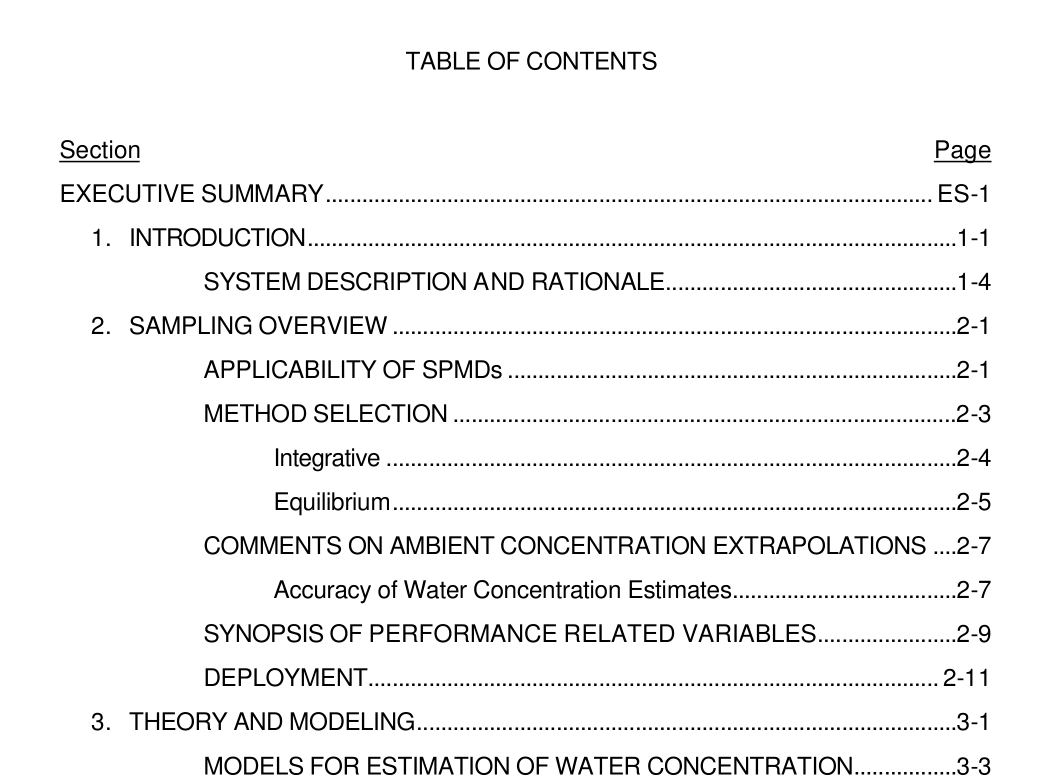API Publ 4690 pdf download

API Publ 4690 pdf download.A Guide for the Use of Semipermeable Membrane Devices (SPMDs) as Samplers of Waterborne Hydrophobic Organic Contaminats
The focus of this work is the aquatic environment, which includes surface water, groundwater, and sediment pore water. Models are presented for estimating ambient concentrations of analytes for surface water and ground water, and environmental-specific limitations are discussed for all three-deployment scenarios. Unfortunately, we are unaware of any equation(s) to accurately relate SPMD levels to pore water concentrations. Use of the mathematical models presented in “THEORY AND MODELING”, page 3-1 , to estimate ambient TWA concentrations from SPMD levels requires calibration or sampling- rate data for analytes of interest. In Section 3 we include laboratory calibration data for PP PAHs and OC pesticides (note that calibration data for PCBs and other analytes are given in Appendix C, page C-1 ). However, successful application of laboratory-generated SPMD calibration data (e.g., sampling rates and K SPMD values) to field deployed SPMDs depends on how closely laboratory- and field-exposure conditions match. To overcome this potential problem, we developed the permeability/performance reference compound (PRC) approach. PRCs are spiked into SPMD lipid prior to deployments. By comparing the amounts of PRC loss during field exposures and calibration studies, an environmental adjustment factor (EAF) can be derived, that permits estimation of actual in situ sampling rates. Using this approach to correct for a wide range of environmental conditions is expected to increase the accuracy of SPMD derived water concentration estimates.
Unlike most sampling methods, SPMDs are applicable to nearly all environmental conditions, selectively sample residues from the dissolved phase, operate in situ, and passively extract hydrophobic organic contaminants from relatively large volumes of water (typically > 10 L for a ≥ 1 0 d exposure to a standard SPMD [see “SPECIFICATIONS OF THE STANDARD SPMD”, page 4-3]). Also, hydrophobic contaminants are generally sampled without affecting the fractional distribution of residues in components of the sampled environment (excludes sediment-soil and some ground water), and fewer analyses (compared to grab samples) are required to assess the chronic exposure of aquatic organisms to contaminants. One of the major advantages of SPMDs over biomonitoring organisms is that a standard design can be used regardless of water quality or environmental conditions. Samplers of uniform and reproducible material are required to delineate differences in sources (e.g., comparison of sample fingerprints or instrumental response profiles using pattern recognition programs) of complex chemical mixtures such as PAHs. In Section 4 we provide key specifications of the commercial or “standard” SPMD. Clearly, a standardized design is a prerequisite for global comparability of SPMD data.Analytical interferences must be minimized in SPMDs to enable detection of trace/ultra- trace levels of hydrophobic contaminants. Because SPMDs sample organic vapors as well as dissolved residues, a clean room is required for the assembly of SPMD components. In addition, careful attention must be paid to adequate precleaning of SPMD materials. Storage and transport conditions must also be designed to minimize air exposure prior to the deployment and after the retrieval of SPMDs.address at a minimum, deployment, retrieval, storage, processing, fractionation, enrichment, and analysis. The exact level of QC required is determined during the development of the experimental design phase of a project and is dependent on project goals. In Section 4, we describe the various types of QC samples that may be used in a project using SPMDs. These include SPMD-fabrication blanks, SPMD-process blanks, reagent blanks, field-blank SPMDs, PRC samples, SPMD spikes, and procedural spikes. The QC samples listed above are designed to provide information on sample integrity and background interferences associated with the entire sampling and analytical process. In general, QC samples represent 20 to 50% of a sample set. Using the materials and procedures described in this document, the precision or coefficient of variation (C.V.) of replicate SPMD analyses is about the same or less than properly executed standard analytical methods (i.e., the C.V.s are typically ≤ 25 %).









